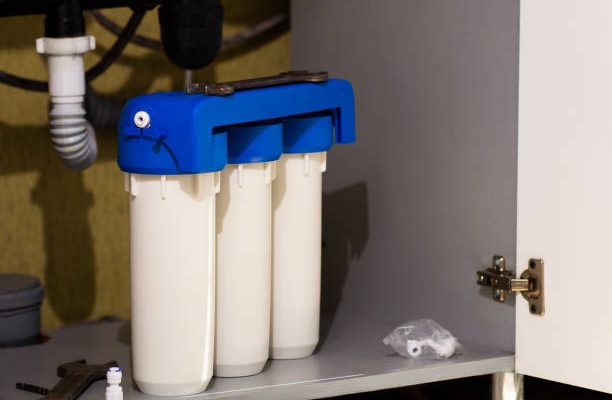The kitchen is the heart of the home and must be updated continuously. One practical way to spice up your kitchen is by adding an under sink water filtration system.
Under sink water filters are specifically designed for convenience and efficiency. Their low cost and easy maintenance are also a huge plus.
This blog post covers how they work, their benefits, the contaminants they remove, and their various types.
What are Under Sink Filters, and How Do They Work?
Under sink filters are point-of-use systems. They are fitted under the sink and filter the water from the sink’s faucet.
How Conventional Under Sink Filters Work
For conventional under sink filters, a plastic tube connected to the cold water pipe supplies the filter with water. After filtration, the filtered water moves through a plastic tube to the filter’s dedicated faucet (conventional under sink filters usually come with their own faucet), which is mounted on the sink.
How Simple Under Sink Filters Work
Simple under sink filters don’t come with a dedicated faucet, so the filter is connected to your main faucet. That way, all the water passing through the cold water line is filtered before it’s delivered through the main cold water faucet. The hot water line remains unfiltered.
How Reverse Osmosis Under Sink Filters Work
Reverse osmosis systems always come with a separate faucet, a pressurized tank, and a pressure pump, making them bulkier than other under sink filters. They also have a more complicated filtration process than conventional and simple under sink filters.
In RO systems, the water is filtered at a slower pace and has to go through different processes before finally getting dispensed.
First, the water goes through a prefilter where sediments and chemicals like chlorine are removed. Then it passes through a semipermeable membrane which is the main filter. The semipermeable membrane traps microparticles, sediments, chemicals, and some bacteria. Next, the water is kept in a pressurized storage tank until it’s needed. Once the faucet is turned on, the pressure shoots the water out from the tank to the postfilter. The postfilter removes any impurities the other stages may have missed.
RO systems eliminate most of the dissolved solids in water. This makes them ideal for people trying to remove as many impurities as possible.
Contaminants Removed by Under Sink Water Filters
Under sink filters typically eliminate very specific contaminants. So, you’ll have to choose a filter that removes the exact impurities present in your water. Sometimes, one filter doesn’t solve the whole problem.
However, under sink filters have recently been designed to accommodate multiple filter stages in their filter housing, allowing homeowners to get rid of a broader range of impurities in their water simultaneously.
Some of the contaminants under sink filters remove include:
- Bacteria
- Viruses
- Protozoa
- Large and small particulates
- Chlorine
- Fluorides
- Toxic chemicals
- Pesticides
- Heavy metals like arsenic and lead
- Volatile organic chemicals (VOCs)
Types of Under Sink Filters
Under sink filters are grouped in different categories based on contaminants they remove, the filter medium they use, the installation process, and economic factors like price ranges. Here’s the most common classification, which is based on the stages of filtration:
Single-Stage Under Sink Filters
Single-stage filters have only one filtration stage and often use one filter media. As a result, they’re useful for targeted filtration, which involves eliminating specific contaminants. Filter media often used in single-stage systems include sediment filters, granular activated carbon, carbon blocks, ion exchange, and iron filters.
Multi-Stage Under Sink Filters
Multi-stage filters treat water in 2 or more stages. Most often, they use more than one filter media. They are more thorough and efficient than single-stage filters because they remove several impurities at once.
Sediment filters are commonly used in the first stage of filtration to remove the large sediments before the water moves on to other stages for further filtration. Specialized filters often featured in multi-stage systems include UV, alkaline, activated carbon, or ultrafiltration devices. This site https://watermasterz.com/under-sink-water-filters/ explains it all.
Benefits of Under Sink Filters
Under sink filters come with a lot of advantages. Aside from their compact design and efficiency, some of their benefits include:
- On-demand access to clean, better tasting, and odor-free water for drinking and other purposes.
- Relatively easy installation process, which you can sometimes do on your own.
- Cheap, easy, and less stressful maintenance since it doesn’t need to be serviced as often as most filters. Most under sink filters only need to be replaced once or twice a year.
- Space-saving designs that don’t take up your whole cabinet.
Under sink filters are a great investment for your home. They’re your best bet for adding value to your kitchen because they are affordable, comfortable, and easy to maintain. They are the one purchase that you’ll definitely not regret.




















